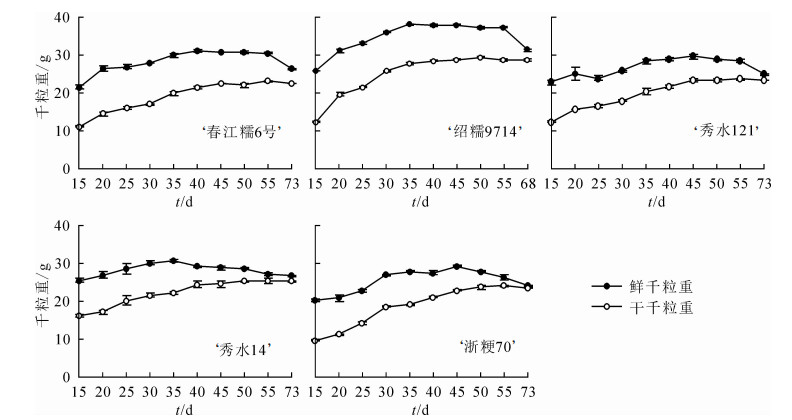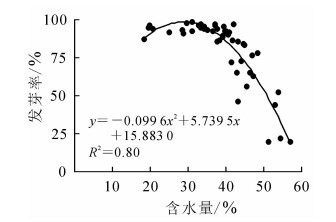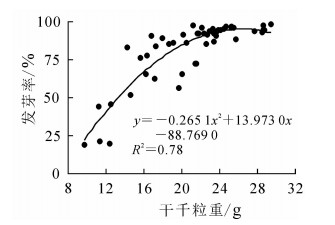-
水稻Oryza sativa是中国的第一大粮食作物,随着人口的不断增长和耕地面积的逐年减少,提高水稻单位面积产量对有效保障国家粮食安全具有重要的意义[1]。随着人们饮食习惯的改变和对生活质量要求的提高,具备优良品质的常规水稻稻米越来越受到欢迎,种植面积也在不断地回升[2]。但是,常规水稻尤其是常规晚稻品种的生育期长,受低温、阴雨等恶劣环境条件影响大,与杂交水稻相比,生育后期繁种技术挑战巨大。种子作为遗传物质的主要载体,其质量高低直接决定了种子萌发、生长发育、抗性、产量等综合表现。种子活力作为评价种子质量最可靠的指标[3],在反映种子田间出苗率、耐储性以及抵御不良环境和病虫杂草的能力上具有重要的参考价值。种子活力在种子生长发育过程中逐渐形成并在生理成熟期达到高峰[4-5]。目前,水稻种子的收获主要是依据经验进行,不当采收时间常对种子质量和产量造成较大的影响。近年来,不少学者通过研究种子发育成熟过程中的形态特征和生理变化判断种子的最佳收获期,但不同作物和品种之间存在差异较大[6-12],不同常规粳稻品种在成熟过程种子质量的变化以及最佳收获时期的报道较少,利用种子质量确定常规粳稻种子最佳收获时期的研究更是空白。因此,了解常规粳稻种子发育成熟过程,掌握种子质量的变化规律,从而确定种子的最佳采收时期,对获得高质量常规粳稻种子及促进农业生产和提高稻米品质具有重要意义。
HTML
-
样地位于浙江省湖州市妙西镇渡善村(30°49′N,119°59′E),属亚热带季风气候,四季分明,年平均气温为15.8 ℃,年平均降水日为142.0~155.0 d,年平均降水量约1 200.0 mm,无霜期224.0~246.0 d,适宜水稻生长。
-
选用‘春江糯6号’(丙02-105/祥湖301)‘Chunjiangnuo 6’、‘绍糯9714’[(绍紫90-12/绍糯45//绍间9)/绍糯119]‘Shaonuo 9714’、‘秀水121’(秀水134//秀水134/GF6)‘Xiushui 121’、‘秀水14’(丙95-59//测212/RH///丙03-123)‘Xiushui 14’和‘浙粳70’(秀水134/ZH0997)‘Zhejing 70’常规粳稻品种为材料。各水稻品种均为常规粳稻类型,生育期适中,均宜在浙江晚粳稻地区种植,其中‘春江糯6号’和‘绍糯9714’为糯型水稻。各品种播种日期、播种方式及相关调查信息见表 1。
品种 种植方式 用种量/(kg·hm-2) 浸种日期(年-月-日) 播种日期(年-月-日) 插秧日期(年-月-日) 齐穗期(年-月-日) 盛花期(年-月-日) ‘春江糯6号’ 插秧 45 2017-05-16 2017-05-21 2017-06-12 2017-09-02 2017-09-09 ‘绍糯9714’ 播种 60 2017-06-10 2017-06-16 2017-09-07 2017-09-14 ‘秀水121’ 插秧 45 2017-05-25 2017-06-01 2017-06-23 2017-09-02 2017-09-09 ‘秀水14’ 播种 60 2017-05-28 2017-06-03 2017-09-02 2017-09-09 ‘浙70’ 插秧 45 2017-05-23 2017-05-28 2017-06-21 2017-09-04 2017-09-09 Table 1. Cultivation and management plan and growth survey of five japonica rice cultivars
-
于盛花期(约80%稻穗扬花)后第15天开始采样,隔5 d取样1次,至正常收获后结束,以正常收获的种子为对照(ck)。其中:‘春江糯6号’‘秀水121’‘秀水14’和‘浙粳70’水稻种子的正常收获期为盛花期后73 d,‘绍糯9714’为盛花期后68 d。取样时随机选取1 m2,全部收割并立即手工脱粒、清选。立即称取鲜千粒重并测定种子含水量;将种子置于网袋自然晾晒,待种子含水量为11%~12%时,再次称取干千粒重。最后将种子储存于塑料收纳箱中室温保存待用。
-
不同时期采收的新鲜粳稻种子的水分含量参照国际种子检验协会(ISTA)[13],采用预烘干处理的测定方法。采收的粳稻种子经脱粒、清选并称质量后,分别随机取2份,25 g·份-1。称取铁丝网盒的质量记为M1,将种子平铺于铁丝网盒中后再次称质量记为M2,然后将铁丝网盒置于预先设定的(103 ± 2)℃的烘箱中预烘30 min,直至水分降到18%,取出冷却至室温,再次记录质量记为M3。将直径为5 cm的铝盒预先烘干、冷却并记录盒号,铝盒称质量记为M4。完成预烘的种子于0.5 mm筛孔的旋风磨中研磨粉碎,迅速称取2份,(4.5 ± 0.5)g·份-1,再次称取质量记为M5。将打开盒盖的铝盒连同粉末置于130~133 ℃的烘箱中烘2 h。烘干结束后,迅速盖上铝盒盒盖并拿出冷却至室温,称质量记为M6。令种子预烘干失去的水分(%)为S1,得到S1=(M2-M3)/(M2-M1)×100%;令2次烘干后失去的水分(%)为S2,得到S2=(M5-M6)/(M5-M4)×100%。计算可知鲜种子含水量=(S1+S2)-(S1×S2)/100%。
-
不同时期采收的新鲜粳稻种子经手工脱粒清选,随机数取种子1 000粒并称质量。待种子自然晾晒干燥后,随机数取种子1 000粒并称质量。重复3次取平均值。
-
裁取15 cm × 15 cm的专用发芽纸,高温高压灭菌后平铺于12 cm × 12 cm × 6 cm的发芽盒;随机数取不同品种不同收获时期的粳稻种子100粒,用质量分数为0.2%的三氯异氰尿酸浸种24 h后,用清水清洗,均匀铺在发芽纸床上。发芽试验条件:30 ℃,光照(光照度为12 000 lx)培养8 h;20 ℃,黑暗培养16 h。每天记录发芽数,参照ISTA[13]标准于第14天统计种子的发芽率。发芽率=(正常发芽种子数/供试种子数)×100%。
-
应用Office 2010和SPSS 19.0(SPSS, Inc., Chicago, IL, USA)软件对数据进行处理和分析;采用S-N-K法进行多重比较,百分率数据经反正弦转换后进行多重比较。
1.1. 样地基本概况
1.2. 实验设计
1.3. 样品采收与处理
1.4. 指标测定与方法
1.4.1. 新鲜种子含水量测定
1.4.2. 千粒重测定
1.4.3. 标准发芽实验
1.5. 统计分析
-
由图 1可知:种子发育初期,各常规粳稻鲜种子含水量均较高;随着收获时间增加,鲜种子含水量逐渐降低。其中:‘春江糯6号’各生育期鲜种子含水量均较高,成熟过程中脱水速率较慢;‘绍糯9714’在盛花期后15~20 d鲜种子含水量下降较快,之后保持平稳降低;‘秀水121’在各成熟期均较低,盛花期后40~55 d降低速率明显加快;‘秀水14’和‘浙粳70’在盛花期后25~40 d基本保持平衡,40 d后下降速度加快。对比发现:正常采收的各粳稻品种鲜种子含水量均最低,且不同粳稻品种之间鲜种子含水量差异较小。
-
由图 2可知:5个常规粳稻种子的鲜千粒重分别于盛花期后40、35、45、35和45 d达到最大值;而后随着鲜种子含水量降低,鲜千粒重不断降低。5个常规粳稻种子的鲜千粒重最大值均出现在盛花期后35~45 d。随着种子生育期的延长,5个常规粳稻种子的干千粒重不断增加,并分别于盛花期后55、50、55、55和55 d达到最大值,然后均趋于稳定或略有下降;5个常规粳稻的干千粒重的最大值均出现在盛花期后50~55 d。由此认为:鲜千粒重达到最大值时,种子的干物质积累并没有达到最大值。
-
由表 2可知:不同粳稻品种种子发芽率均随种子成熟度的增加而升高,达到最大值后略有下降。其中‘春江糯6号’‘绍糯9714’‘秀水121’和‘秀水14’种子发芽率均于盛花期后50 d达到最大值,较对照分别增加了4.7%、3.5%、7.1%和1.0%,‘浙粳70’粳稻种子分别于盛花期后40 d和50 d达到最大值,较对照增长了1.4%,但与正常收获的种子相比,差异均未达到显著性水平。结合图 2可知:种子干千粒重达到最大值时或达到最大值之前,种子的发芽率已经达到最大值,即适时早收既能保证种子千粒重,亦可获得发芽率较高的种子。
生长时长/d 发芽率/% ‘春江糯6号’ ‘绍糯9714’ ‘秀水121’ ‘秀水14’ ‘浙粳70’ 15 21.7 ± 2.1 e 19.7 ± 3.2 d 46.0 ± 1.7 c 78.0 ± 4.6 b 19.3 ± 9.5 c 20 52.0 ± 3.6 d 56.3 ± 2.1 c 76.6 ± 3.5 b 84.3 ± 2.9 b 44.0 ± 10.4 b 25 65.3 ± 5.1 c 72.7 ± 12.2 b 90.5 ± 0.7 a 91.7 ± 2.3 a 83.0 ± 5.3 a 30 62.7 ± 3.5 c 88.7 ± 2.5 a 89.3 ± 3.2 a 92.7 ± 2.1 a 85.7 ± 4.0 a 35 65.3 ± 7.2 c 93.7 ± 2.5 a 86.3 ± 3.1 a 92.5 ± 0.7 a 86.3 ± 3.1 a 40 72.3 ± 5.9 c 93.3 ± 2.1 a 92.3 ± 1.5 a 95.3 ± 3.5 a 95.3 ± 2.1 a 45 85.7 ± 0.6 b 94.7 ± 0.6 a 92.5 ± 3.5 a 96.7 ± 0.6 a 93.7 ± 3.1 a 50 96.0 ± 0.0 a 98.3 ± 0.6 a 93.5 ± 4.9 a 97.0 ± 1.7 a 95.3 ± 1.2 a 55 95.3 ± 2.9 a 98.0 ± 2.0 a 91.0 ± 5.3 a 96.0 ± 1.7 a 94.3 ± 0.6 a 正常收获 91.7 ± 3.1 ab 95.0 ± 2.8 a 87.3 ± 9.5 a 96.0 ± 1.7 a 94.0 ± 1.0 a 说明:同列不同小写字母表示同一粳稻品种不同处理间差异显著(P<0.5) Table 2. Germination rateseeds harvested at different maturity stage in five japonica rice cultivars
-
由表 3可知:不同粳稻品种不同成熟度收获的种子,鲜种子含水量、鲜千粒重和干千粒重与发芽率均呈显著或极显著的相关性。其中:‘秀水14’和‘浙粳70’鲜种子含水量与标准发芽率呈显著负相关,‘春江糯6号’‘绍糯9714’和‘秀水121’鲜种子含水量与发芽率呈极显著负相关。鲜千粒重和干千粒重均与发芽率呈显著或极显著的正相关,不同粳稻品种种子的干千粒重与发芽率的相关系数均较鲜千粒重高。
项目 ‘春江糯6号’(n=10) ‘绍糯7914’(n=10) ‘秀水121’(n=10) ‘秀水14’(n=10) ‘浙粳70’(n=10) 鲜种子含水量 -0.87** -0.87** -0.81** -0.71* -0.71* 鲜千粒重 0.74** 0.87** 0.64** 0.44* 0.79** 干千粒重 0.93** 0.98** 0.79** 0.86** 0.87** 说明:*表示显著相关(P<0.5),**表示极显著相关(P<0.1) Table 3. Correlation between water content of fresh seeds and 1000-grain weight and germination rate of different rice seeds with different maturity
对所有粳稻品种鲜种子含水量与发芽率建立二次项回归方程,得到拟合方程:y=-0.099 6x2+5.739 5x+15.883 0(R2=0.80)。经回归关系显著性检验和回归系数的t检验得知,拟合方程具有极显著的回归关系,即该方程具有极显著的统计学意义(图 3)。因此,当要求种子的发芽率达到85%时,鲜种子含水量要求为17.1%~40.5%。结合表 2可知:当鲜种子含水量为17.1%~40.5%时,5个粳稻品种种子采收分别为盛花期后45~73 d(‘春江糯6号’)、30~68 d(‘绍糯9714’)、30~73 d(‘秀水121’)、30~73 d(‘秀水14’)和45~73 d(‘浙粳70’),对应种子的发芽率分别为85.7%~96.0%、88.7%~98.3%、89.3%~93.5%、92.7%~97.0%和93.7%~95.3%。该方程拟合结果与实验结果一致,因此,可用该方程模型预测种子发芽率。

Figure 3. Quadratic regression equationbetween water content of fresh seedsand standard germination rate
干千粒重与发芽率的回归方程y=-0.265 1x2+13.973 0x-88.769 0(R2=0.78),经回归显著性检验及回归系数t检验可知:该方程具有极显著的统计学意义(图 4)。当要求种子的发芽率为85%时,种子干千粒重为20.1~32.6 g。结合图 2可知,当种子干千粒重为20.1~32.6 g时,不同品种种子采收分别为盛花期后35~73 d(‘春江糯6号’)、25~68 d(‘绍糯9714’)、35~73 d(‘秀水121’)、25~73 d(‘秀水14’)和40~73 d(‘浙粳70’),对应种子的发芽率分别为65.3%~96.0%、72.7%~98.3%、86.3%~93.5%、91.7%~97.0%和93.7%~95.3%。其中‘春江糯6号’和‘绍糯9714’种子的干千粒重在方程求解范围内对应发芽率的最小值均未达到85%以上,因此,该方程模型对种子发芽率的预测存在一定的误差。
2.1. 不同成熟度鲜种子的含水量
2.2. 不同成熟度种子的千粒重
2.3. 不同成熟度种子的发芽率
2.4. 鲜种子含水量和千粒重与发芽率的相关性分析
-
水稻种子在发育成熟过程中,内部的脱落酸、维生素E、寡聚糖、蛋白质等物质大量积累,共同参与种子活力的形成[5]。本研究发现:种子千粒重随生育期的延长不断增加,达到最大值后趋于稳定;随着采收时期的延长,种子在植株上呼吸消耗,导致其内部积累的有机物质含量降低。张桂莲等[14]研究表明:种子在获得最大干质量时品质最好,之后活力和发芽率均下降。种子完成形态成熟后,形态特征和物理特性基本稳定,不同类型水稻品种种子的色泽、形状和大小均不再变化,并且同一品种的大粒种子较小粒种子活力更高[15-16]。TURK等[17]和ZAIDMAN等[18]研究表明:种子的质量与活力呈显著正相关,种子质量越大,活力越高。此外,千粒重的变化受种子水分含量的影响,不同粳稻品种的鲜种子含水量在发育初期最高,随着成熟度的增加,鲜含水量逐渐降低,至正常采收时最低,与王艳等[19]的研究结果一致。种子在发育成熟过程中,鲜千粒重均较干千粒重提前达到最大值,而干千粒重仍随成熟度的增加持续上升,最后与鲜千粒重逐渐接近并趋于稳定。陈路路[20]通过研究小麦Triticum aestivum种子在成熟过程中的脱水保护机制发现:小麦种子发育成熟进入脱水阶段后,种子内部的过氧化物酶活性、超氧化物歧化酶活性、可溶性糖和可溶性蛋白质含量因脱水胁迫均有不同程度的升高,使种子耐脱水胁迫抗性增强,因脱水而受到的损伤降低,即成熟度越高,鲜种子含水量越少,其活力也越高。
常规粳稻种子的发芽率随着生育期的延长即种子成熟度的增加而逐渐升高,当达到最高峰时,发芽率趋于稳定;当收获时期继续延长,种子会因环境条件的影响发生劣变和老化,导致活力下降[19, 21]。本研究发现:‘春江糯6号’‘绍糯9714’‘秀水121’和‘秀水14’种子的发芽率最大值都在盛花期后50 d,‘浙粳70’在盛花期后第40天最大,第45天略有降低,第50天时再一次到达高点,但差异不显著;相比而言,第50天收获的鲜种子含水量更低而千粒重更高,因此认为盛花期后50 d为‘浙粳70’种子的最佳收获期。由此认为,在种子干千粒重达到最大值时或达到最大值之前,种子发芽率已经达到最大值,并且其干千粒重与正常收获的种子相比均无显著差异,即可以通过适当提早收获获得发芽率较高的种子,而种子的千粒重和产量等也未受到显著的影响。
相关性分析结果表明:不同粳稻品种种子发芽率与鲜种子含水量、鲜千粒重和干千粒重均有显著或极显著的相关性。其中鲜种子含水量与种子发芽率均呈显著或极显著的负相关,种子鲜千粒重和干千粒重均与种子发芽率呈显著或极显著正相关,且种子干千粒重与发芽率的相关系数更高,各品种相关性均达到极显著水平。二次项回归分析发现:5个粳稻品种的鲜种子含水量和干千粒重与发芽率的拟合度均较高,均达到极显著水平。说明通过建立回归方程,根据种子在发育成熟过程中鲜种子含水量及干千粒重的变化,可对常规粳稻种子的发芽率进行快速且较准确的预测。但通过对回归方程建模结果的比较发现,干千粒重与发芽率拟合方程的求解结果与实际实验结果存在一定的差异,其中‘春江糯6号’和‘绍糯9714’不同成熟度种子的干千粒重在拟合方程求解范围内对应的发芽率最小值未达到指定标准,可能是受到品种之间差异的影响。这表明,用干千粒重对种子发芽率进行建模预测存在一定的局限性。鲜种子含水量可能受品种差异的影响较小,其对种子发芽率具有简单、快速和准确的预测效果。
综上所述,随着成熟度的增加,不同粳稻品种种子的质量均逐渐升高。种子在发育成熟过程中,千粒重和发芽率均不断升高,达到最大值后趋于平稳;收获过迟则会引起种子质量下降。鲜种子含水量在种子发育初期较高,随着种子成熟度的增加则不断降低。种子发芽率在种子完成形态成熟时或完成形态成熟前达到最大值,与种子发育成熟过程中的鲜种子含水量和干千粒重具有极显著的相关性及二次项回归关系。通过建立回归方程,可根据发育成熟过程中鲜种子含水量的变化对种子发芽率进行预测。这为常规粳稻种子适时早收及简单、快速和准确地预测种子发芽率提供了理论依据,但由于品种种类较少以及区域环境的差异,仍有待于进一步的研究。

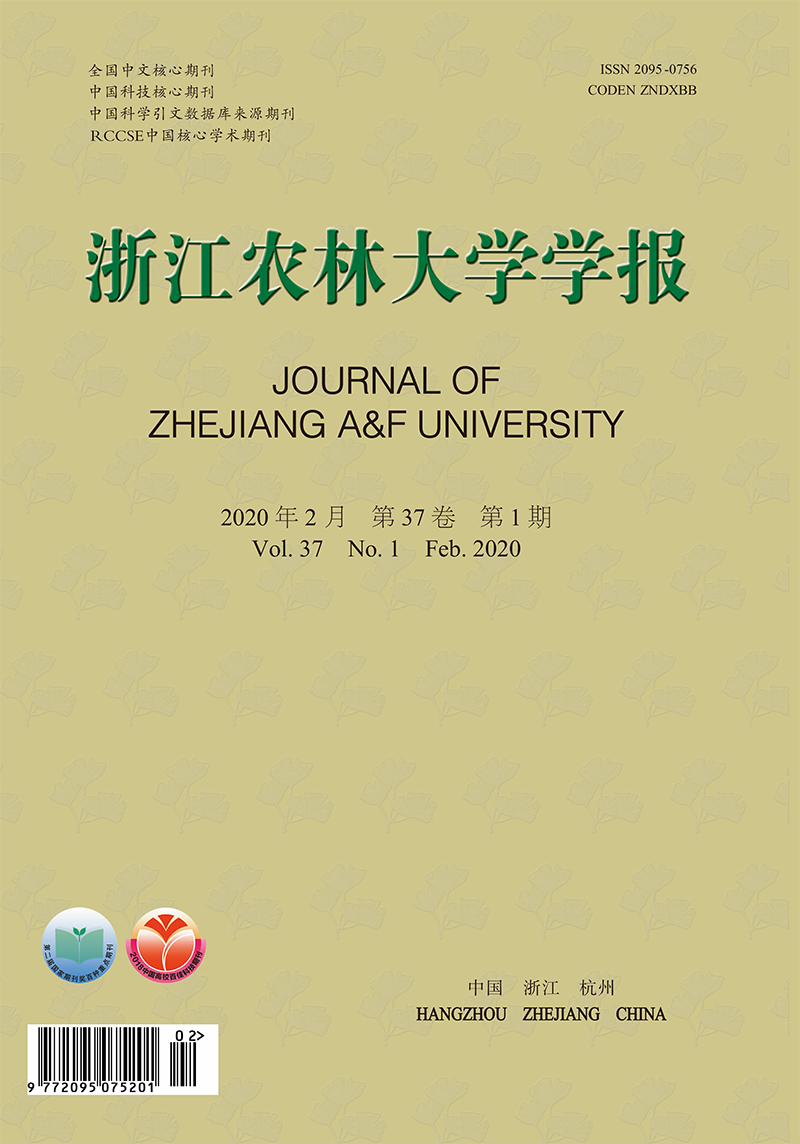


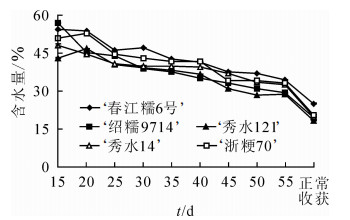





 DownLoad:
DownLoad:
